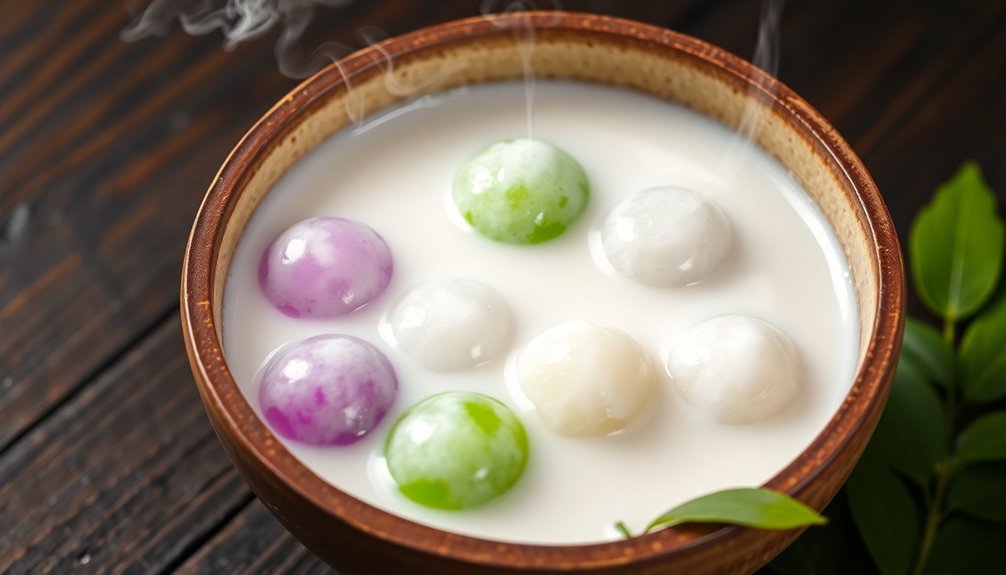Bua Loy - Rice Balls in Coconut Milk
You'll love Bua Loy, a cherished Thai dessert that combines chewy glutinous rice balls with sweet, creamy coconut milk. The name means "floating lotus," reflecting how these small, pillowy spheres float in their aromatic bath. You can make this comforting treat at home using simple ingredients like rice flour, coconut milk, and sugar, with optional pandan leaves for color. This traditional celebration dessert's blend of textures and flavors offers a gateway into authentic Thai cuisine.
Key Takeaways
- Bua Loy is a Thai dessert consisting of chewy glutinous rice flour balls served in sweet coconut milk soup.
- The rice balls are made by mixing glutinous rice flour with water and rolling into marble-sized spheres.
- Cook the rice balls in boiling water until they float, then transfer them to sweetened coconut milk.
- The dessert's name means "floating lotus" and it's traditionally served warm during celebrations and gatherings.
- Key ingredients include glutinous rice flour, coconut milk, sugar, and salt, with optional pandan leaves for coloring.
History

While the exact origins of Bua Loy remain unclear, this traditional Thai dessert has been enjoyed for generations throughout Thailand, particularly in the central region.
You'll find it has deep cultural significance, often served during important traditional celebrations like Loy Krathong, where its floating rice balls symbolize unity and completeness.
The name "Bua Loy" literally translates to "floating lotus," referring to how the glutinous rice balls float in warm, sweet coconut milk, much like lotus flowers on water.
Through the years, Thai families have passed down their own variations of this beloved dessert, with some adding natural food coloring from pandan leaves or butterfly pea flowers to create vibrant, multicolored rice balls that enhance its visual appeal.
Recipe

Ingredients:
- 1 cup glutinous rice flour
- 1/2 cup water
- 2 cups coconut milk
- 1/2 cup sugar
- 1/4 teaspoon salt
- Pandan leaves (optional)
Instructions:
- Mix glutinous rice flour with water gradually until it forms a smooth, pliable dough.
- Roll small portions of dough into marble-sized balls.
- Bring a pot of water to boil.
- Drop the rice balls into boiling water.
- Cook until they float to the surface (2-3 minutes).
- Remove with a slotted spoon and set aside.
- In a separate pot, combine coconut milk, sugar, and salt.
- Add pandan leaves if using.
- Heat the mixture over medium heat, stirring until sugar dissolves.
- Remove pandan leaves.
- Add cooked rice balls to the coconut milk mixture.
- Simmer for 2-3 minutes.
- Serve warm.
Serves: 4-6 people
Preparation time: 30 minutes
Cooking time: 15 minutes
Cooking Steps

You'll start by mixing rice flour with water to form a smooth, pliable dough that can be shaped into small, marble-sized balls.
Next, bring a pot of water to a gentle boil before adding your prepared coconut milk mixture to create the sweet, creamy base.
Once the coconut milk is simmering, carefully drop in the rice balls one by one, allowing them to cook until they float to the surface.
Step 1. Mix Rice Flour and Water
Begin by combining 1 cup of glutinous rice flour with ¼ cup of room temperature water in a medium mixing bowl.
Using your fingers, gradually mix the ingredients until they form a soft, pliable dough. If the mixture's too dry, add water one teaspoon at a time. If it's too wet, incorporate small amounts of rice flour until you achieve the right consistency.
You'll know you've reached the proper water proportions when the dough doesn't stick to your hands but remains soft enough to shape.
Knead the mixture gently for about 2-3 minutes until it becomes smooth and elastic. The dough should feel similar to play-dough and hold its shape when rolled into small balls.
Don't overwork the dough, as this can make your rice balls tough.
Step 2. Shape Into Small Balls
Once your dough has reached the ideal consistency, pinch off small portions and roll them between your palms to form balls about the size of a marble (roughly 1/2 inch in diameter).
You'll want to work quickly but carefully to guarantee uniform sizing, as this will help the balls cook evenly later.
For texture variations, you can incorporate different types of rice flour or add ingredients like pandan extract or matcha powder to the dough before shaping.
These flavor enhancements won't just add color but will also introduce unique taste profiles to your bua loy.
As you shape each ball, place them on a lightly floured surface to prevent sticking.
Don't let them touch each other, or they might stick together.
You'll know you've achieved the right texture when the balls feel smooth and hold their shape firmly.
Step 3. Boil Water in Pot
The initial cooking step requires filling a medium-sized pot with 4-5 cups of water and bringing it to a rolling boil over high heat.
While the boiling techniques are straightforward, you'll need to maintain the right water temperature to cook the rice balls properly.
Watch for large bubbles breaking consistently on the surface - this indicates your water has reached the ideal temperature of 212°F (100°C).
Don't reduce the heat yet, as you'll want to keep the water at a steady boil for the rice balls.
The vigorous bubbling creates the perfect environment for cooking the glutinous rice balls evenly and preventing them from sticking together.
If you notice the water level dropping too much during the process, you can add more hot water to maintain the right volume.
Step 4. Add Prepared Coconut Milk
After your rice balls finish cooking, reduce the heat to medium-low and carefully pour in 2 cups of prepared coconut milk.
You'll want to choose quality coconut milk, as it's essential for both taste and coconut benefits like healthy fatty acids and immune-boosting properties. You can use different milk varieties, from full-fat to light coconut milk, depending on your preference.
- Stir gently to prevent the coconut milk from curdling.
- Keep the heat low enough that small bubbles form but don't let it boil.
- Let the mixture simmer for 3-4 minutes to combine flavors.
- Check consistency - it should be creamy but not too thick.
Watch the mixture carefully during this step, as coconut milk can separate if it gets too hot. Adjust the heat as needed to maintain a gentle simmer.
Step 5. Drop Rice Balls Gently
Dropping your rice balls into the simmering coconut milk requires a delicate touch to prevent splashing and maintain their shape.
Using a small spoon, scoop one rice ball at a time and carefully lower it just above the liquid's surface before releasing. Don't drop them from too high, as this can cause them to break apart or create a mess.
One of the essential cooking techniques is to space the rice balls evenly in the pot, preventing them from sticking together.
You'll notice texture variations as they cook - they'll float to the surface when they're done, usually within 2-3 minutes.
Work in small batches to avoid overcrowding, which can lead to uneven cooking. Once they're floating, use a slotted spoon to transfer them to serving bowls.
Cooking Tips

Making perfect bua loy requires careful attention to water temperature and dough consistency.
You'll want to maintain a gentle simmer, not a rolling boil, to guarantee your rice balls cook evenly. When it comes to cooking techniques, focus on working with small batches to prevent overcrowding and sticking.
- Test the water temperature by dropping one rice ball first - it should float within 30 seconds.
- Add rice balls in batches of 8-10 to maintain proper cooking temperature.
- Remove floating balls promptly to prevent overcooking.
- Don't skip the ice water bath after cooking.
For ingredient substitutions, you can use pandan extract instead of fresh leaves, and coconut cream can be thinned with water if coconut milk isn't available.
Keep stirring the coconut milk gently to prevent it from separating while cooking.
Final Thoughts
Although bua loy may seem challenging at first, this beloved Thai dessert rewards your effort with its delightful combination of chewy rice balls and creamy coconut milk.
Once you've mastered the basic recipe, you'll discover why this dessert holds such cultural significance in Thai cuisine, often served during celebrations and family gatherings.
Don't hesitate to explore dessert variations by adding pandan essence, purple sweet potato, or taro to create colorful rice balls.
You can also experiment with the sweetness level of the coconut milk or try serving it warm or chilled.
Whether you're making it for a special occasion or simply craving a comforting Thai treat, bua loy offers a satisfying blend of textures and flavors that you'll want to make again and again.
Frequently Asked Questions
Can Bua Loy Be Made Ahead of Time and Reheated?
Through the steam rising from your warm bowl, you'll find these chewy delights can be prepared ahead. Store the components separately and reheat gently, combining just before serving for best results.
How Long Can Leftover Bua Loy Be Stored in the Refrigerator?
You can store your leftovers in an airtight container for up to 3 days in the fridge. For best storage tips, keep the rice balls separate from coconut milk to extend shelf life.
Is It Possible to Freeze Bua Loy for Later Consumption?
While you can freeze these dumplings, freezing methods will affect their texture changes. You'll notice they become slightly harder and less chewy when thawed, though they're still edible.
Can Artificial Food Coloring Be Used Instead of Natural Ingredients?
You can use artificial coloring, but natural alternatives like pandan, butterfly pea flowers, or pumpkin provide authentic flavors and healthier options while achieving similar vibrant colors in your desserts.
